Spatiotemporal Evolution Mechanism and Dynamic Simulation of the Urban Resilience System in the Chengdu–Chongqing Economic Circle
Abstract
1. Introduction
2. Construction of Research Framework
2.1. Study Area
2.2. Components of Urban Resilience
- Subjectivity: the capacity of government, enterprises, communities, residents, NPOs, and other system actors to address, learn from, adapt to, and regenerate in response to environmental changes.
- Diversity: urban infrastructure for water supply and drainage, transportation, flood control, communication, and epidemic prevention should be planned and constructed according to the standards of networked, distributed, and parallel connectivity.
- Autonomy: the ability of various actors and urban units within the city to interconnect, thereby enabling them to prevent, mitigate, and respond to disasters effectively.
- Appropriate redundancy: urban infrastructure construction should incorporate adequate buffer space to enhance resilience by preventing, mitigating, and responding to disasters through the interconnectedness of various actors and urban units.
2.3. Evaluation Model of a Resilient City System (RCS)
2.4. Structure of a Resilient City System (RCS)
3. Indicator System Construction
- (1)
- ER: Comprehensive support for the city’s resilience to risks
- Economic volume: GDP per capita (X1) reflects the total economic output of the region and the income level of its residents and serves as the core indicator of the economic base.
- Growth speed: Tertiary sector as a share of GDP (X5) indicates the speed of economic structural optimization and directly influences long-term development potential.
- Consumption stimulation: Urban disposable income per capita (X3) and total retail sales of consumer goods (X12) links to analyze the vitality of consumption and assess the ability to drive domestic demand.
- Emergency preparedness: General budget revenue from local finances (X4) is a critical resource for addressing economic shocks, and its absence would weaken emergency response capacity.
- Economic structure: Number of industrial enterprise units above a designated size (X2) is linked to economic diversification, and reliance on a single industry will significantly reduce economic resilience.
- (2)
- SR: Safeguarding people’s lives and urban stability
- The social resilience of the CCEC is evaluated through five key indicators: healthcare, employment, urban scale, education, and residential consumption vitality. The interconnections among these factors hinge on the synergy between human capital development and public service provision. Specifically, investments in education enhance workforce quality, thereby promoting employment structure optimization. Stable employment ensures sustained consumption capacity, while vibrant consumption activity generates new job opportunities. Enhanced consumption vitality increases tax revenues, enabling further investments in education and healthcare systems. High-quality healthcare and education systems attract population agglomeration (thereby elevating urbanization rates), and the resulting economies of scale reduce the costs of public service delivery.
- Medical care level: The number of beds in health facilities (X7) directly determines the ability to respond to public health emergencies and serves as a fundamental guarantee for life safety.
- Employment structure: The share of urban registered unemployed in the total population (X8), as a negative indicator, reflects the degree of social stability; an excessively high unemployment rate exacerbates social vulnerability. The percentage of employees in the tertiary sector (X9) reflects economic dynamism and employment absorption capacity. Together, these two indicators provide a more objective assessment of the regional employment structure.
- Urbanization scale: Population density (X11), natural population growth rate (X13), and the urbanization rate of the resident population (X14) jointly influence resource allocation efficiency; both excessively high or low levels may lead to management imbalances.
- Consumption dynamism: Total retail sales of consumer goods (X12) and urban disposable income per capita (X3) together reveal the market’s internal circulation capacity, and their combination provides a more comprehensive evaluation of social dynamism.
- Investment in education: Education expenditure as a share of fiscal expenditure (X10) affects the accumulation of human capital, and long-term neglect weakens social adaptability.
- (3)
- ECR: Maintaining environmental security and sustainability
- The greening level: The greening ratio of built-up areas (X15) and parkland per capita (X17) together measure the ecological carrying capacity of urban areas.
- Pollution treatment: The non-hazardous domestic waste disposal rate (X18) and centralized sewage treatment rate (X19) reflect the effectiveness of environmental governance. Monitoring only the treatment rates while ignoring municipal wastewater discharges (X20) may lead to an underestimation of ecological pressure. The share of environmental protection expenditure in fiscal expenditure (X16) reflects the government’s ability to support environmental governance financially.
- Pollution level: Municipal wastewater discharges (X20), as a negative indicator, directly reflect environmental risks and potential crises.
- (4)
- IR: Safeguarding the daily and emergency operations of the city
- Urban evacuation capacity: Road area per capita (X21) reflects the availability of safe passage to safeguard residents during emergencies. Length of urban drainage pipes (X23) reflects the city’s ability to discharge floodwater. Together, these two indicators determine the overall evacuation efficiency and emergency response capacity in disaster scenarios.
- Resource supply: Water penetration rate (X24) and city gas penetration rate (X22) serve as the basic guarantees for sustaining residents’ daily lives.
- Resource utilization efficiency: Daily domestic water consumption per capita (X25), as a negative indicator, can be combined with the supply indicators to comprehensively assess the sustainability of resource management.
- (5)
- OMR: Strengthening urban governance and risk response
- Social security: The number of urban workers enrolled in basic pension insurance at the end of the year (X26) reflects the government’s ability to ensure foundational support and promote long-term social stability.
- Public management: The proportion of public administration and social organization personnel relative to the total population (X27) directly impacts administrative efficiency. Understaffing may weaken the speed or effectiveness of emergency response.
4. Materials and Methods
4.1. Data Sources
4.2. Methodology
4.2.1. Entropy Weight–TOPSIS Evaluation Model
4.2.2. Kernel Density Estimation
4.2.3. Standard Deviation Ellipse Analysis
4.2.4. Geographical Detector Model
4.2.5. Gray Prediction Model
4.2.6. Geostatistical Trend Analysis Method
5. Results
5.1. Characteristics of the Spatiotemporal Evolution of UR
5.1.1. Characteristics of Time-Series Evolution
5.1.2. GIS Visual Analysis of Urban Resilience
5.1.3. Kernel Density Estimation Analysis
5.1.4. Standard Deviation Ellipse Analysis of Urban Resilience
5.1.5. Spatial Heterogeneity Detection
5.2. Dynamic Simulation Evolution of the UR
5.2.1. Analysis of Prediction Results
5.2.2. Spatial Development Trend of the UR Level
6. Conclusions and Policy Implications
6.1. Conclusions
- Between 2012 and 2022, the UR of the CCEC transitioned from a “single-core” model centered on Chongqing to a “dual-core” model featuring both Chongqing and Chengdu. The overall level of UR in the study area improved, exhibiting a spatial differentiation pattern with two prominent wings and a concave center. Additionally, the spatial shaping capacity of UR was strengthened by the influence of cities in southern Sichuan.
- In terms of influencing factors, there were significant variations in the extent to which various factors influenced the level of UR. Factors such as economic diversity, economic emergency response capacity, economic resilience, healthcare level, and urban supply and drainage capacity demonstrated a more pronounced positive influence. Indicators with stronger explanatory power were primarily concentrated in the economic, social, and infrastructure dimensions.
- In terms of dynamic prediction, during the period of 2025 to 2035, the study area is expected to exhibit prominent high points in UR. However, the resilience levels of most cities will remain relatively low, demonstrating an overall trend of slow yet steady growth. The status of regional central cities such as Chongqing and Chengdu will be further consolidated, and the spatial pattern of UR, characterized by “two prominent wings and a central depression”, will become more pronounced.
6.2. Policy Implications
- (1)
- To address the widening gap in UR levels, cities should adopt collaborative management strategies to dismantle barriers between urban resources such as human capital, logistics information, and capital flows. This will enhance interdepartmental communication, optimize resource allocation, strengthen the capacity of cities to jointly mitigate risks, and promote synergy development in urban regions.
- (2)
- In response to the persistent expansion of disparities in urban emergency response capabilities, the self-organization and flexibility of residents, communities, and other key actors in resilient urban systems should be fully leveraged. This will encourage their active participation in resilience governance and foster a collective resilience management system that spans from residents to communities and ultimately involves government oversight.
- (3)
- To tackle the imbalance in urban factor endowments, a differentiated resilience enhancement strategy should be implemented based on the current resilience development levels of individual cities. The central cities should amplify their spillover effects to surrounding regions, while peripheral areas should actively learn from and adapt the successful practices of central cities. This approach will effectively guide the positive influence of highly resilient cities, counteract the “siphon” effect, and reduce polarization.
Author Contributions
Funding
Institutional Review Board Statement
Informed Consent Statement
Data Availability Statement
Conflicts of Interest
References
- Shao, Y.W.; Xu, J. Understanding Urban Resilience: A Conceptual Analysis Based on Integrated International Literature Review. Urban Plan. Int. 2015, 30, 48–54. [Google Scholar]
- Lyu, Y.F.; Xiang, M.T.; Wang, M.J.; Wu, C.F. From Disaster Prevention to Resilience Construction: Exploration and Prospect of Resilience Planning under the Background of Territorial Governance. J. Nat. Resour. 2021, 36, 2281–2293. [Google Scholar] [CrossRef]
- Berkes, F.; Folke, C. Linking Social and Ecological Systems for Resilience and Sustainability; Beijer Discussion Paper Series No. 52; Beijer International Institute of Ecological Economics, The Royal Swedish Academy of Sciences: Stockholm, Sweden, 1994; pp. 2–16. [Google Scholar]
- Holling, C.S. Resilience and Stability of Ecological Systems. Annu. Rev. Ecol. Syst. 1973, 4, 1–23. [Google Scholar] [CrossRef]
- Cutter, S.L.; Ahearn, J.A.; Amadei, B.; Crawford, P.; Eide, E.A.; Galloway, G.E.; Goodchild, M.F.; Kunreuther, H.C.; Li-Vollmer, M.; Schoch-Spana, M.; et al. Disaster Resilience: A National Imperative. Environ. Sci. Policy Sustain. Dev. 2013, 55, 25–29. [Google Scholar] [CrossRef]
- Ribeiro, P.J.G.; Gonçalves, L.A.P.J. Urban Resilience: A Conceptual Framework. Sustain. Cities Soc. 2019, 50, 101625. [Google Scholar] [CrossRef]
- Ozbay, A.E.O.; Karapinar, I.S.; Unen, H.C. Integrated Urban Resilience Framework: A Comprehensive Approach to Pre-and Post-Disaster Assessment for Earthquake Risk Reduction. Struct. Eng. Mech. 2024, 92, 197–206. [Google Scholar]
- Park, S.; Yabe, T.; Ukkusuri, S.V. Post-Disaster Recovery Policy Assessment of Urban Socio-Physical Systems. Comput. Environ. Urban Syst. 2024, 114, 102184. [Google Scholar] [CrossRef]
- Yu, J.; Hu, W.; Hou, L. Towards More Resilient Cities-Analyzing the Impact of New-Type Urbanization on Urban Resilience: Considering Spatial Spillover Boundaries. Sustain. Cities Soc. 2024, 114, 105735. [Google Scholar] [CrossRef]
- Zhang, J.; Wang, T.; Goh, Y.M.; He, P.; Hua, L. The Effects of Long-Term Policies on Urban Resilience: A Dynamic Assessment Framework. Cities 2024, 153, 105294. [Google Scholar] [CrossRef]
- Bruneau, M.; Chang, S.E.; Eguchi, R.T.; Lee, G.C.; O’Rourke, T.D.; Reinhorn, A.M.; Shinozuka, M.; Tierney, K.; Wallace, W.A.; Von Winterfeldt, D. A Framework to Quantitatively Assess and Enhance the Seismic Resilience of Communities. Earthq. Spectra 2003, 19, 733–752. [Google Scholar] [CrossRef]
- Cutter, S.L.; Barnes, L.; Berry, M.; Burton, C.; Evans, E.; Tate, E.; Webb, J. A Place-Based Model for Understanding Community Resilience to Natural Disasters. Glob. Environ. Change 2008, 18, 598–606. [Google Scholar] [CrossRef]
- Wu, C.; Cenci, J.; Wang, W.; Zhang, J. Resilient City: Characterization, Challenges and Outlooks. Buildings 2022, 12, 516. [Google Scholar] [CrossRef]
- Zhao, R.D.; Fang, C.L.; Liu, H.M. Progress and Prospect of Urban Resilience Research. Prog. Geogr. 2020, 39, 1717–1731. [Google Scholar] [CrossRef]
- Ruan, J.; Chen, Y.; Yang, Z. Assessment of Temporal and Spatial Progress of Urban Resilience in Guangzhou under Rainstorm Scenarios. Int. J. Disaster Risk Reduct. 2021, 66, 102578. [Google Scholar] [CrossRef]
- Shi, Y.; Zhai, G.; Xu, L.; Zhou, S.; Lu, Y.; Liu, H.; Huang, W. Assessment Methods of Urban System Resilience: From the Perspective of Complex Adaptive System Theory. Cities 2021, 112, 103141. [Google Scholar] [CrossRef]
- Guo, Z.; Li, Z.; Lu, C.; She, J.; Zhou, Y. Spatio-Temporal Evolution of Resilience: The Case of the Chengdu-Chongqing Urban Agglomeration in China. Cities 2024, 153, 105226. [Google Scholar] [CrossRef]
- Li, H.; Wang, Y.; Zhang, H.; Yin, R.; Liu, C.; Wang, Z.; Fu, F.; Zhao, J. The Spatial-Temporal Evolution and Driving Mechanism of Urban Resilience in the Yellow River Basin Cities. J. Clean. Prod. 2024, 447, 141614. [Google Scholar] [CrossRef]
- Wang, H.; Xue, H.; He, W.; Han, Q.; Xu, T.; Gao, X.; Liu, S.; Jiang, R.; Huang, M. Spatial-Temporal Evolution Mechanism and Dynamic Simulation of the Urban Resilience System of the Guangdong-Hong Kong-Macao Greater Bay Area in China. Environ. Impact Assess. Rev. 2024, 104, 107333. [Google Scholar] [CrossRef]
- Xu, J.; Shao, Y. Resilient Cities: A New Shift to Urban Crisis Management. Urban Plan. Int. 2015, 30, 1–3. [Google Scholar]
- Zhao, S.; Zeng, W.; Feng, D. Coupling Coordination of Urban Resilience and Urban Land Use Efficiency in Hunan Province, China. Sustainability 2024, 16, 10860. [Google Scholar] [CrossRef]
- Hofmann, S.Z. 100 Resilient Cities Program and the Role of the Sendai Framework and Disaster Risk Reduction for Resilient Cities. Prog. Disaster Sci. 2021, 11, 100189. [Google Scholar] [CrossRef]
- Meerow, S.; Newell, J.P.; Stults, M. Defining Urban Resilience: A Review. Landsc. Urban Plan. 2016, 147, 38–49. [Google Scholar] [CrossRef]
- Holland, J.H. Hidden Order. Bus. Week-Domest. Ed. 1995, 21, 112–148. [Google Scholar]
- Liu, S.-C.; Peng, F.-L.; Qiao, Y.-K.; Dong, Y.-H. Quantitative Evaluation of the Contribution of Underground Space to Urban Resilience: A Case Study in China. Undergr. Space 2024, 17, 1–24. [Google Scholar] [CrossRef]
- Yao, F.; Li, L.; Liang, J. Spatial and Temporal Evolution of Urban Resilience in China and Analysis of Barriers: Based on a Sustainable Development Perspective. PLoS ONE 2024, 19, e0285113. [Google Scholar] [CrossRef]
- Zhang, S.; Ma, X.; Cui, Q.; Liu, J. Digitalization and Urban Resilience: How Does the Allocation of Digital Factors Affect Urban Resilience under Energy Constraints in China? Environ. Dev. Sustain. 2024, 26, 23613–23641. [Google Scholar] [CrossRef]
- Pan, H.; Yang, Y.; Zhang, W.; Xu, M. Research on Coupling Coordination of China’s Urban Resilience and Tourism Economy—Taking Yangtze River Delta City Cluster as an Example. Sustainability 2024, 16, 1247. [Google Scholar] [CrossRef]
- Sun, J.; Zhai, N.; Mu, H.; Miao, J.; Li, W.; Li, M. Assessment of Urban Resilience and Subsystem Coupling Coordination in the Beijing-Tianjin-Hebei Urban Agglomeration. Sustain. Cities Soc. 2024, 100, 105058. [Google Scholar] [CrossRef]
- Yi, P.; Wang, S.; Li, W.; Dong, Q. Urban Resilience Assessment Based on “Window” Data: The Case of Three Major Urban Agglomerations in China. Int. J. Disaster Risk Reduct. 2023, 85, 103528. [Google Scholar] [CrossRef]
- Liu, W.; Zhou, J.; Li, X.; Zheng, H.; Liu, Y. Urban Resilience Assessment and Its Spatial Correlation from the Multidimensional Perspective: A Case Study of Four Provinces in North-South Seismic Belt, China. Sustain. Cities Soc. 2024, 101, 105109. [Google Scholar] [CrossRef]
- You, X.; Sun, Y.; Liu, J. Evolution and Analysis of Urban Resilience and Its Influencing Factors: A Case Study of Jiangsu Province, China. Nat. Hazards 2022, 113, 1751–1782. [Google Scholar] [CrossRef] [PubMed]
- Liu, R.; Zhang, L.; Tang, Y.; Jiang, Y. Understanding and Evaluating the Resilience of Rural Human Settlements with a Social-Ecological System Framework: The Case of Chongqing Municipality, China. Land Use Policy 2024, 136, 106966. [Google Scholar] [CrossRef]
- Wen, H.; Huang, J.; Qian, L.; Li, Z.; Zhang, Y.; Zhang, J. The Spatial-Temporal Evolution Patterns of Landslide-Oriented Resilience in Mountainous City: A Case Study of Chongqing, China. J. Environ. Manag. 2024, 370, 122963. [Google Scholar] [CrossRef]
- Xiu, C.; Wei, Y. Urban Resilience Assessment of Dalian City Based on “Scale-Density-Morphology”. J. Geogr. 2018, 73, 2315–2328. [Google Scholar]
- Wang, Y.-C.; Shen, J.-K.; Xiang, W.-N.; Wang, J.-Q. Identifying Characteristics of Resilient Urban Communities through a Case Study Method. J. Urban Manag. 2018, 7, 141–151. [Google Scholar] [CrossRef]
- The Plan for the Construction of the Chengdu-Chongqing Economic Circle was jointly issued by the Central Committee of the Communist Party of China (CPC Central Committee) and the State Council of the People’s Republic of China. Available online: https://www.gov.cn/zhengce/2021-10/21/content_5643875.htm (accessed on 5 October 2024).
- Luo, K. Draft Plan for the Physiographic Regionalization of China. Acta Geogr. Sin. 1954, 379–394. Available online: https://kns.cnki.net/kcms2/article/abstract?v=O_n6o0K2eioPwWtLwjzXigQJBrADnuXR47r486CTTTbuEgGblhxHROhAOaFvYEE0uovAlzsC-rwRJLbbifvDwOSzO2wtfdXqMwurgb5kOXifRMU39sUF0If9FxxK2BJTpCSHjprOanaRrtwEfGuS-HSgQZ9mD2ms1CkjvdGF001i9AC6ykI9Mo2YuD1T_Cl7&uniplatform=NZKPT&language=CHS (accessed on 11 October 2024).
- Baoxing, Q. Resilient Urban Design Methods and Principles Based on the Complex Adaptive System Theory. Landsc. Archit. Front. 2018, 6, 42–47. [Google Scholar] [CrossRef]
- Fan, W.C. Modernizing Public Safety Governance with the Construction of a Safe and Resilient City. Frontiers 2022, 14–24. [Google Scholar] [CrossRef]
- Nyström, M.; Jouffray, J.-B.; Norström, A.V.; Crona, B.; Søgaard Jørgensen, P.; Carpenter, S.R.; Bodin, Ö.; Galaz, V.; Folke, C. Anatomy and Resilience of the Global Production Ecosystem. Nature 2019, 575, 98–108. [Google Scholar] [CrossRef]
- Chen, P. Effects of the Entropy Weight on Topsis. Expert Syst. Appl. 2021, 168, 114186. [Google Scholar] [CrossRef]
- Chen, Y.-C. A Tutorial on Kernel Density Estimation and Recent Advances. Biostat. Epidemiol. 2017, 1, 161–187. [Google Scholar] [CrossRef]
- Gong, J. Clarifying the Standard Deviational Ellipse. Geogr. Anal. 2002, 34, 155–167. [Google Scholar] [CrossRef]
- Song, Y.; Wang, J.; Ge, Y.; Xu, C. An Optimal Parameters-Based Geographical Detector Model Enhances Geographic Characteristics of Explanatory Variables for Spatial Heterogeneity Analysis: Cases with Different Types of Spatial Data. GISci. Remote Sens. 2020, 57, 593–610. [Google Scholar] [CrossRef]
- Tien, T.-L. A Research on the Grey Prediction Model Gm (1, N). Appl. Math. Comput. 2012, 218, 4903–4916. [Google Scholar] [CrossRef]
- Poizot, E.; Mear, Y.; Thomas, M.; Garnaud, S. The Application of Geostatistics in Defining the Characteristic Distance for Grain Size Trend Analysis. Comput. Geosci. 2006, 32, 360–370. [Google Scholar] [CrossRef]
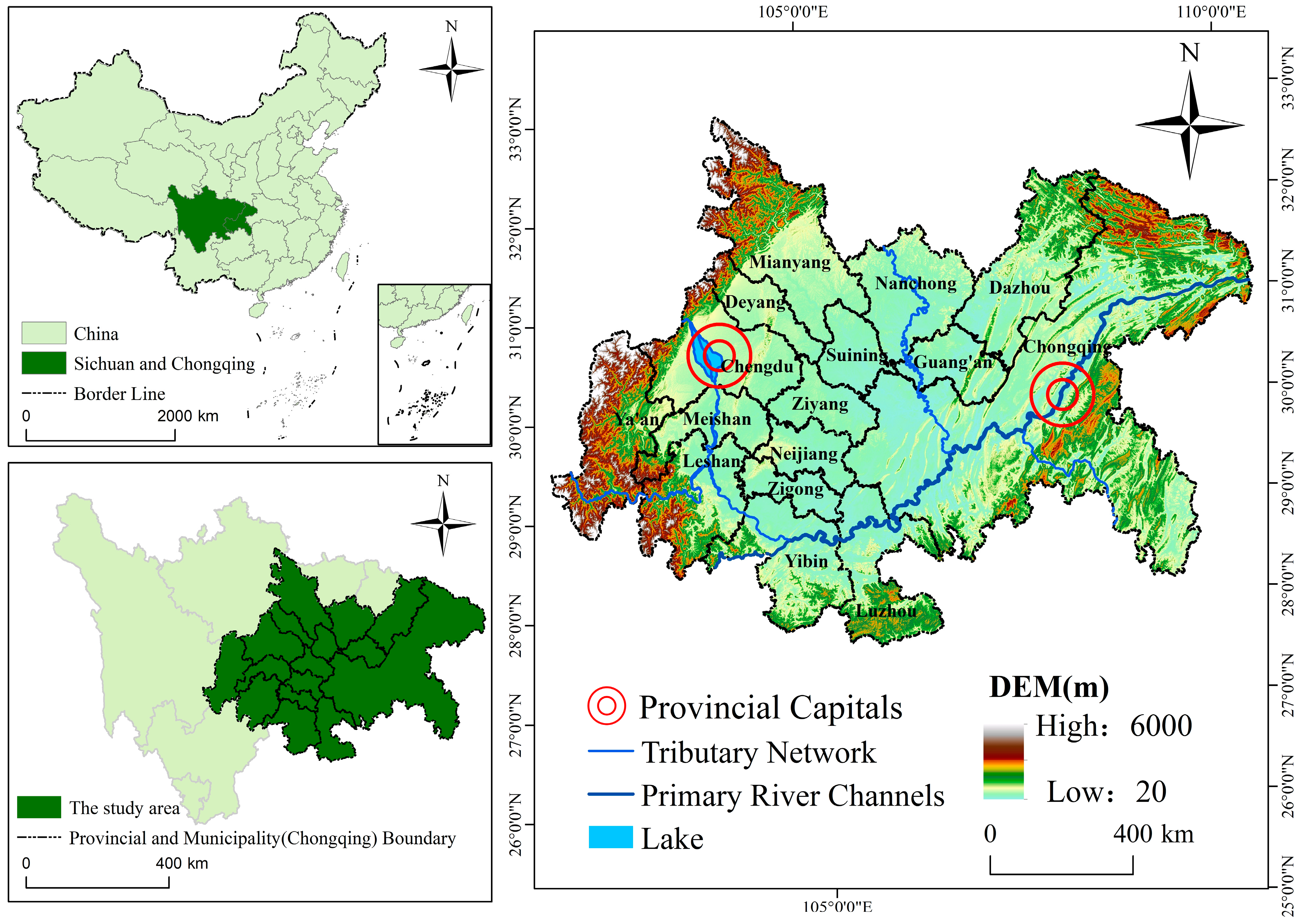
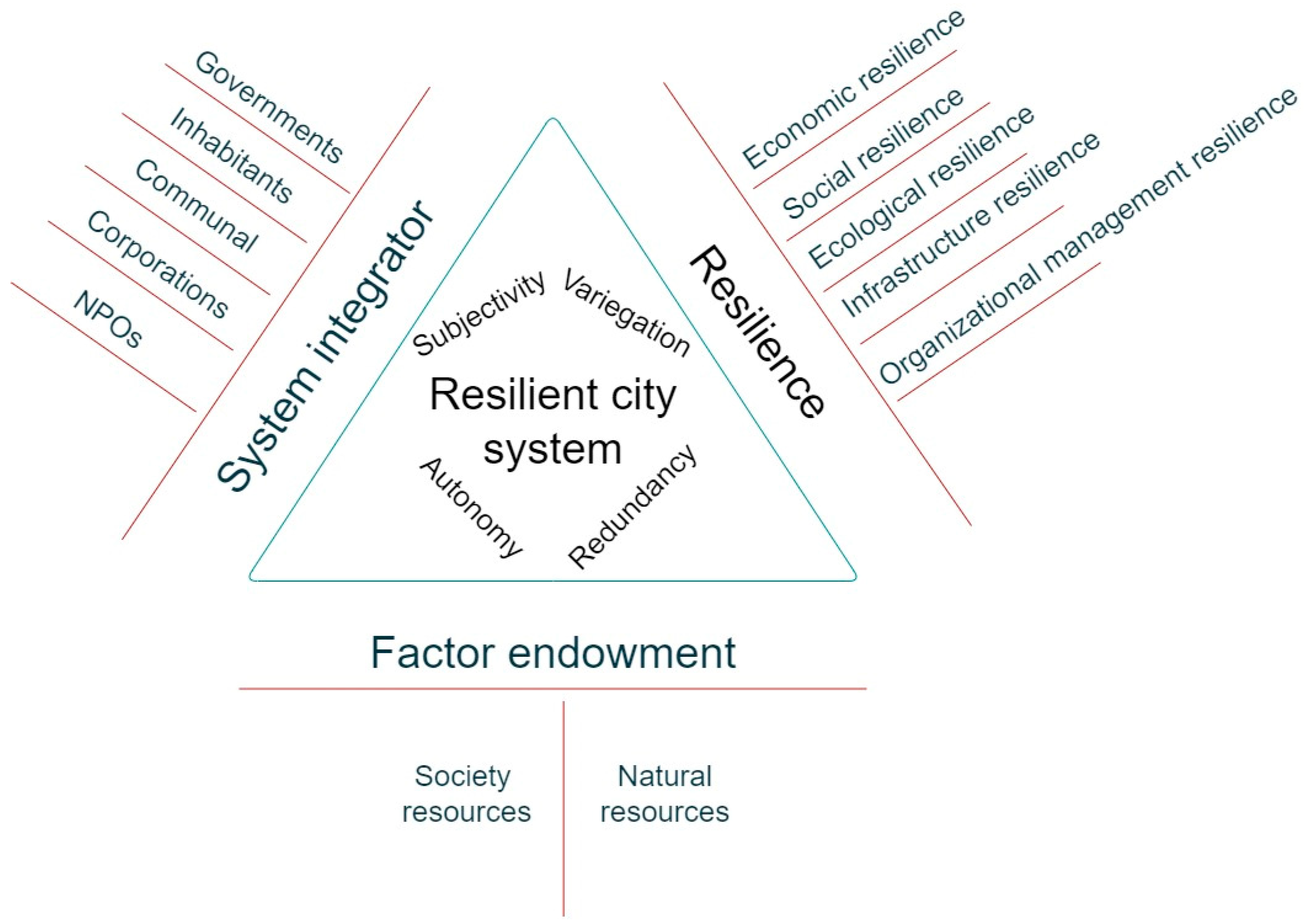



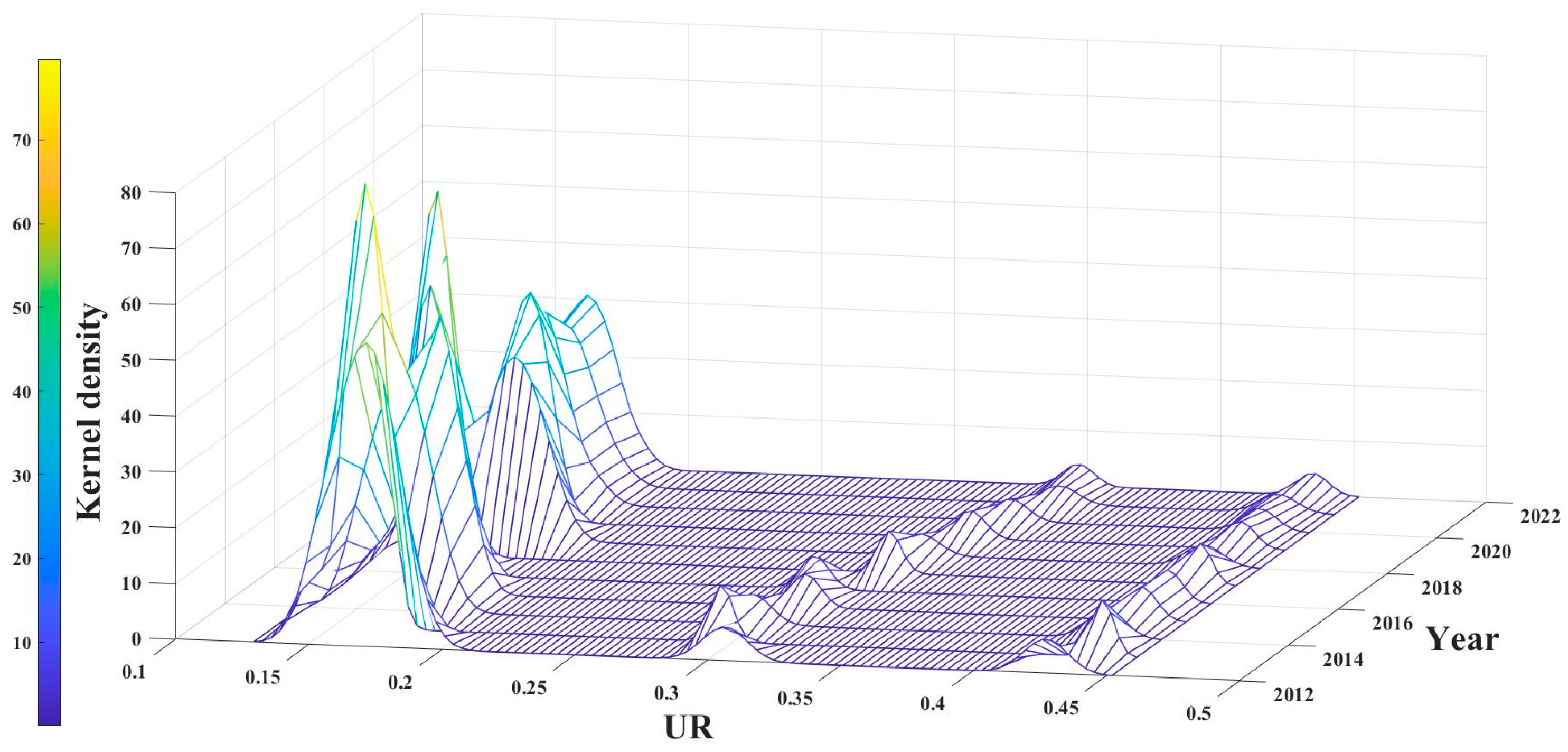
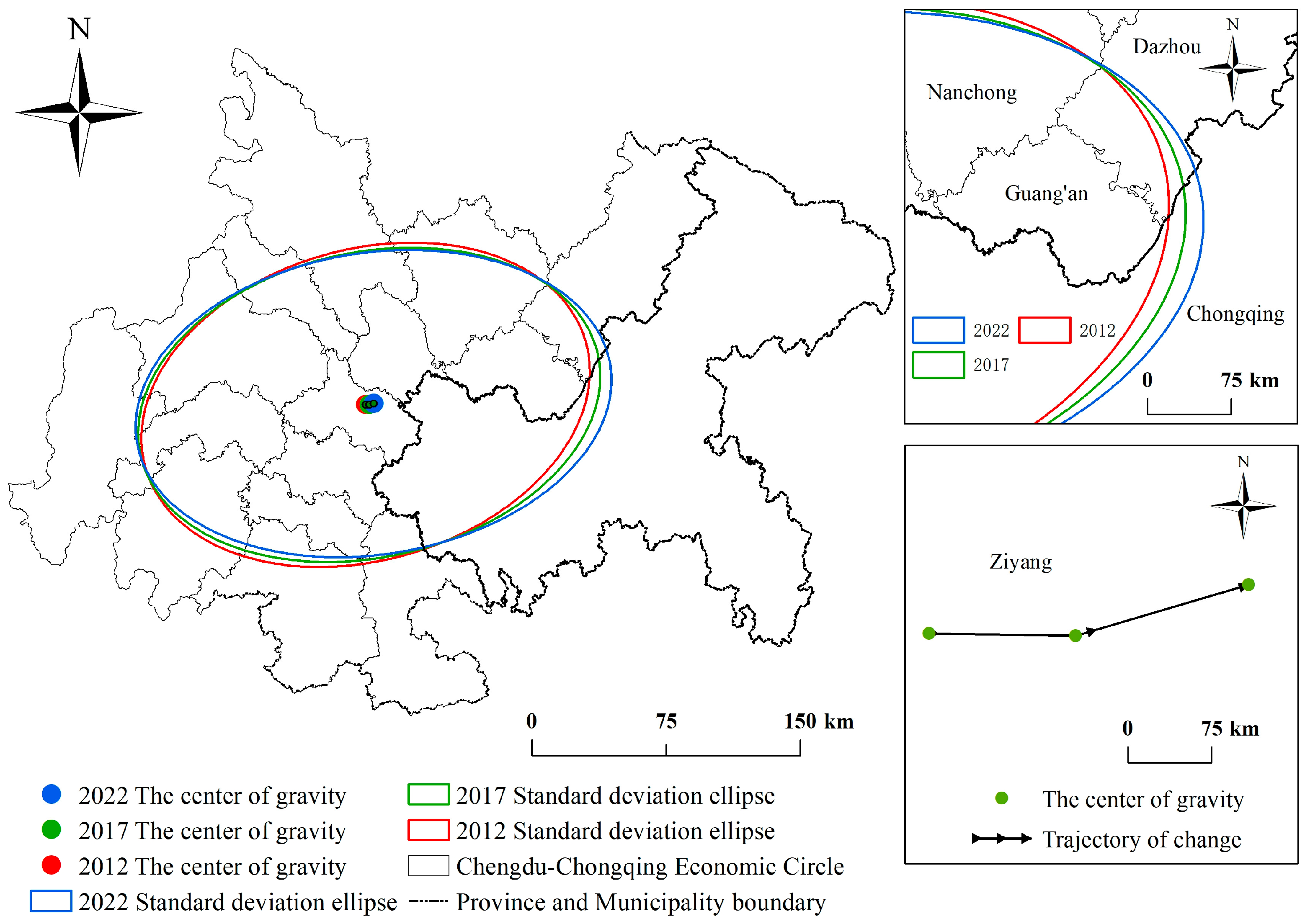
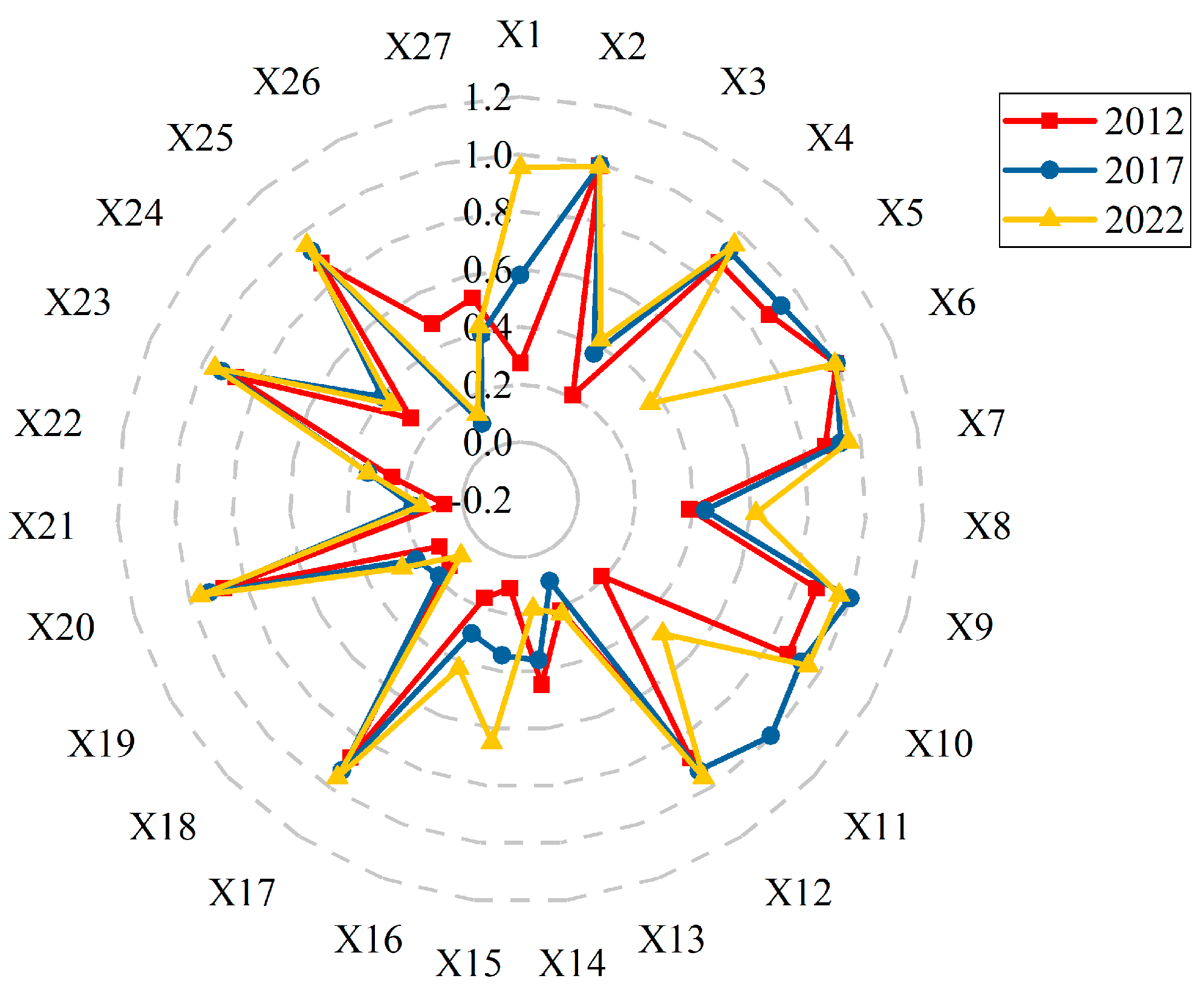

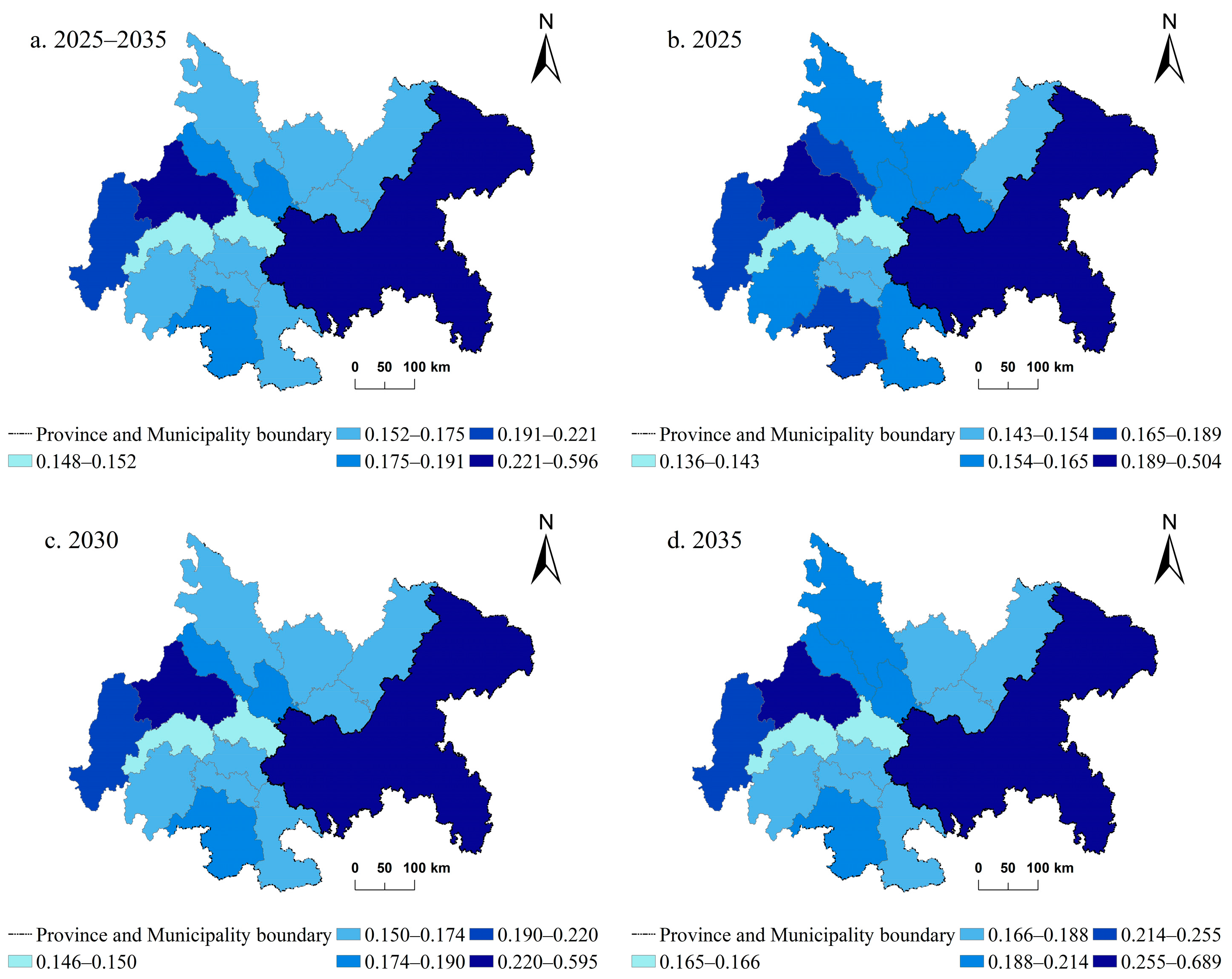

| Target Layer | Criterion Layer | Indicator Layer | Units | Properties | Indicator Meaning |
|---|---|---|---|---|---|
| Urban resilience | ER | GDP per capita (X1) | CNY | + | Level of economic performance |
| Number of industrial enterprise units above designated size (X2) | Enterprises | + | Economic diversity | ||
| Urban disposable income per capita (X3) | CNY | + | Social spending power | ||
| General budget revenue from local finances (X4) | CNY | + | Economic emergency response capacity | ||
| Tertiary sector as a share of GDP (X5) | % | + | Economic structure | ||
| Balance of deposits in financial institutions per capita (X6) | CNY/People | + | Economic resilience | ||
| SR | Number of beds in health facilities (X7) | Sheet | + | Level of healthcare | |
| Share of urban registered unemployed in total population (X8) | % | − | Unemployment structure | ||
| Percentage of employees in the tertiary sector (X9) | % | + | Structure of employed persons | ||
| Education expenditure as a share of fiscal expenditure (X10) | % | + | Level of investment in education | ||
| Population density (X11) | People/km2 | + | Level of urban agglomeration | ||
| Total retail sales of consumer goods (X12) | Billions CNY | + | Market consumption dynamics | ||
| Natural population growth rate (X13) | % | + | Rate of population growth | ||
| Urban rate of resident population (X14) | % | + | Scale of urbanization | ||
| ECR | Greening ratio of built-up areas (X15) | % | + | Level of urban greenery | |
| Share of environmental protection expenditure in fiscal expenditure (X16) | % | + | Level of environmental inputs | ||
| Parkland per capita (X17) | m2 | + | Environmental conservation level | ||
| Non-hazardous domestic waste disposal rate (X18) | % | + | Environmental remediation | ||
| Centralized sewage treatment rate (X19) | % | + | Environmental responsiveness | ||
| Municipal wastewater discharges (X20) | m3 | − | Ecological governance pressures | ||
| IR | Road area per capita (X21) | m2 | + | Urban evacuation capacity | |
| City gas penetration rate (X22) | % | + | Supply of gas resources | ||
| Length of urban drainage pipes (X23) | Km | + | Urban supply and drainage capacity | ||
| Water penetration rate (X24) | % | + | Water availability | ||
| Daily domestic water consumption per capita (X25) | L/People | − | Water utilization | ||
| OMR | Number of urban workers enrolled in basic pension insurance at the end of the year (X26) | People | + | Social security capacity | |
| Public administration and social organizations as a proportion of the total population (X27) | % | + | Level of social management |
| Year | Ellipse Area/km2 | Short Semi-Axis /m | Long Semi-Axis /m | Azimuth/° | Coordinates of the Center of Gravity /(E,W) | Traveling Distance/km |
|---|---|---|---|---|---|---|
| 2012 | 89,268,544,843.18 | 204,673.31 | 138,840.01 | 73.90 | 105°23′, 30°17′ | — |
| 2017 | 89,567,661,585.85 | 209,228.12 | 136,273.00 | 77.66 | 105°26′, 30°17′ | 0.184 |
| 2022 | 90,697,072,435.88 | 214,276.54 | 134,740.60 | 80.80 | 105°30′, 30°18′ | 1.311 |
| Rankings | 2012 | 2017 | 2022 | |||
|---|---|---|---|---|---|---|
| Index | q | Index | q | Index | q | |
| No. 1 | X6 | 0.993 | X2 | 0.996 | X6 | 0.990 |
| No. 2 | X2 | 0.992 | X6 | 0.996 | X2 | 0.989 |
| No. 3 | X5 | 0.878 | X9 | 0.996 | X20 | 0.960 |
| No. 4 | X7 | 0.875 | X11 | 0.996 | X1 | 0.955 |
| No. 5 | X9 | 0.875 | X5 | 0.929 | X7 | 0.957 |
| No. 6 | X4 | 0.874 | X4 | 0.928 | X9 | 0.956 |
| No. 7 | X12 | 0.874 | X7 | 0.928 | X12 | 0.956 |
| No. 8 | X20 | 0.874 | X9 | 0.928 | X17 | 0.956 |
| No. 9 | X25 | 0.874 | X20 | 0.927 | X4 | 0.955 |
| No. 10 | X10 | 0.873 | X25 | 0.927 | X9 | 0.955 |
| Cities | Projected Urban Resilience | ||||||||||
|---|---|---|---|---|---|---|---|---|---|---|---|
| 2025 | 2026 | 2027 | 2028 | 2029 | 2030 | 2031 | 2032 | 2033 | 2034 | 2035 | |
| Chongqin | 0.504 | 0.522 | 0.540 | 0.558 | 0.577 | 0.595 | 0.614 | 0.633 | 0.651 | 0.670 | 0.689 |
| Chengdu | 0.401 | 0.416 | 0.432 | 0.448 | 0.464 | 0.479 | 0.495 | 0.511 | 0.527 | 0.543 | 0.559 |
| Zigong | 0.150 | 0.152 | 0.153 | 0.156 | 0.158 | 0.161 | 0.164 | 0.168 | 0.171 | 0.175 | 0.179 |
| Luzhou | 0.156 | 0.158 | 0.160 | 0.162 | 0.164 | 0.167 | 0.170 | 0.173 | 0.177 | 0.180 | 0.184 |
| Deyang | 0.170 | 0.173 | 0.177 | 0.181 | 0.185 | 0.190 | 0.194 | 0.199 | 0.204 | 0.209 | 0.214 |
| Mianyang | 0.156 | 0.159 | 0.162 | 0.166 | 0.169 | 0.174 | 0.178 | 0.183 | 0.188 | 0.193 | 0.198 |
| Suining | 0.165 | 0.167 | 0.170 | 0.172 | 0.175 | 0.178 | 0.181 | 0.185 | 0.188 | 0.192 | 0.195 |
| Neijiang | 0.154 | 0.156 | 0.158 | 0.160 | 0.163 | 0.166 | 0.170 | 0.174 | 0.177 | 0.181 | 0.186 |
| Leshan | 0.156 | 0.158 | 0.161 | 0.164 | 0.167 | 0.170 | 0.173 | 0.177 | 0.181 | 0.184 | 0.188 |
| Nanchong | 0.159 | 0.160 | 0.162 | 0.164 | 0.166 | 0.168 | 0.171 | 0.173 | 0.176 | 0.179 | 0.182 |
| Meishan | 0.143 | 0.143 | 0.144 | 0.146 | 0.148 | 0.150 | 0.153 | 0.155 | 0.159 | 0.162 | 0.166 |
| Yibin | 0.169 | 0.172 | 0.175 | 0.178 | 0.181 | 0.185 | 0.188 | 0.192 | 0.196 | 0.200 | 0.204 |
| Guang’an | 0.163 | 0.164 | 0.165 | 0.167 | 0.168 | 0.170 | 0.172 | 0.175 | 0.177 | 0.180 | 0.182 |
| Dazhou | 0.148 | 0.150 | 0.152 | 0.155 | 0.158 | 0.162 | 0.166 | 0.170 | 0.174 | 0.179 | 0.184 |
| Ya’an | 0.189 | 0.195 | 0.201 | 0.207 | 0.214 | 0.220 | 0.227 | 0.234 | 0.241 | 0.248 | 0.255 |
| Ziyang | 0.136 | 0.137 | 0.139 | 0.141 | 0.143 | 0.146 | 0.149 | 0.153 | 0.156 | 0.160 | 0.165 |
| Average | 0.195 | 0.199 | 0.203 | 0.208 | 0.213 | 0.218 | 0.223 | 0.228 | 0.234 | 0.240 | 0.246 |
Disclaimer/Publisher’s Note: The statements, opinions and data contained in all publications are solely those of the individual author(s) and contributor(s) and not of MDPI and/or the editor(s). MDPI and/or the editor(s) disclaim responsibility for any injury to people or property resulting from any ideas, methods, instructions or products referred to in the content. |
© 2025 by the authors. Licensee MDPI, Basel, Switzerland. This article is an open access article distributed under the terms and conditions of the Creative Commons Attribution (CC BY) license (https://creativecommons.org/licenses/by/4.0/).
Share and Cite
Huang, H.; Yang, X. Spatiotemporal Evolution Mechanism and Dynamic Simulation of the Urban Resilience System in the Chengdu–Chongqing Economic Circle. Sustainability 2025, 17, 3448. https://doi.org/10.3390/su17083448
Huang H, Yang X. Spatiotemporal Evolution Mechanism and Dynamic Simulation of the Urban Resilience System in the Chengdu–Chongqing Economic Circle. Sustainability. 2025; 17(8):3448. https://doi.org/10.3390/su17083448
Chicago/Turabian StyleHuang, Huiqin, and Xia Yang. 2025. "Spatiotemporal Evolution Mechanism and Dynamic Simulation of the Urban Resilience System in the Chengdu–Chongqing Economic Circle" Sustainability 17, no. 8: 3448. https://doi.org/10.3390/su17083448
APA StyleHuang, H., & Yang, X. (2025). Spatiotemporal Evolution Mechanism and Dynamic Simulation of the Urban Resilience System in the Chengdu–Chongqing Economic Circle. Sustainability, 17(8), 3448. https://doi.org/10.3390/su17083448






